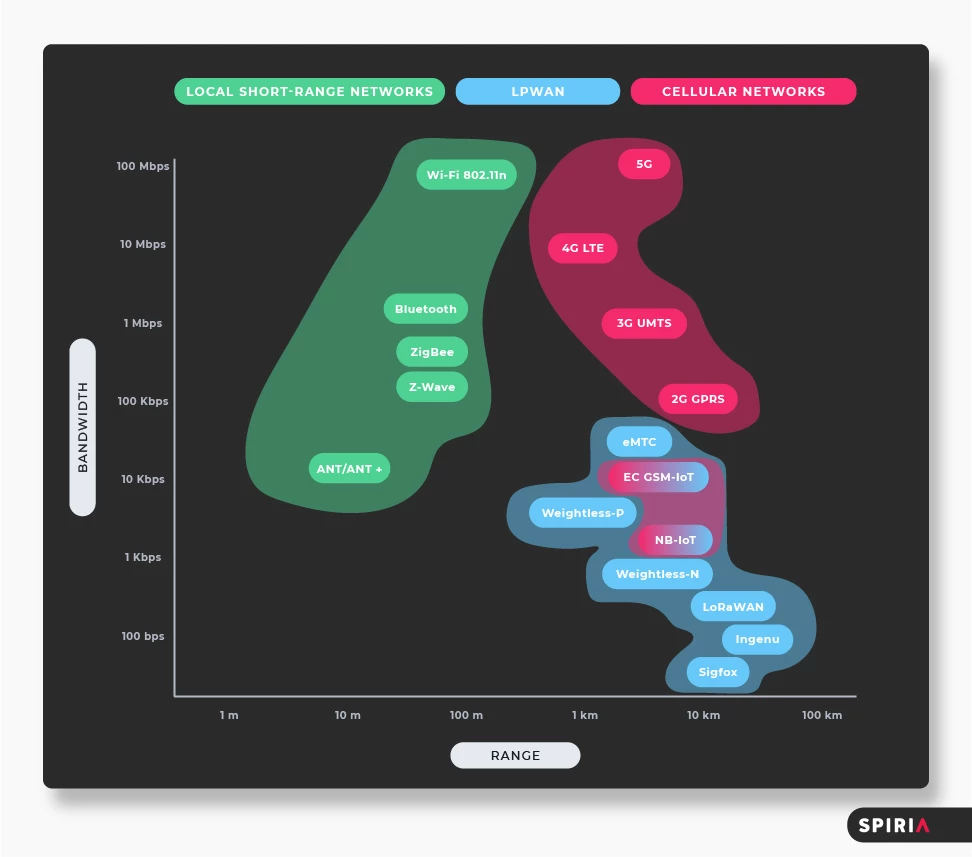A quick overview of the networks for IoT/M2M

Connected objects are communicating objects which, by definition, must be connected to a network in order to ensure the exchange of data, most often over the Internet. Most IoT/M2M applications use wireless networks, but there are a few exceptions, such as objects that communicate via Powerline Communication (PLC). But for the purposes of this article, we’ll be looking at the most frequent case — wireless communication.
There are three main types of wireless links for connected objects:
1. Local short-range networks
Depending on the technology used, the communication range spans a few dozen centimetres to a few hundred metres (in open environments). Some examples of this technology are:
- EnOcean,
- Z-Wave,
- ANT, ANT+,
- IEEE 802.15.4,
- Zigbee,
- Thread,
- Bluetooth Low Energy (BLE),
- Bluetooth,
- IEEE 802.11.xx,
- Wi-Fi,
- etc.
These technological solutions meet the needs of many connected objects in the fields of home automation, wearables and industry, among others, as long as their use is confined within a restricted perimeter (home, building, store, factory), or is always in close proximity to a mobile gateway (e.g. a connected watch close to a telephone, an ANT+ sensor close to a sports monitoring device).
2. Cellular networks
The communication range, very dependent on the environment, ranges from 500m to up to 40km. These networks are the ones used by mobile operators:
Mobile phone networks are based on complex protocols and offer high data transfer rates. The trade-off is high power consumption, which means that devices often need to be recharged. As a result, they are not well suited for IoT/M2M applications. These applications are often limited to low data rates and sporadic communications; the energy and financial cost (subscription) of the telephone network is too high to justify its use.
Based on mobile phone infrastructures, cellular networks dedicated to IoT/M2M have been created:
- eMTC/LTE-M,
- NB-IoT,
- EC-GSM-IoT,
- etc.
These solutions offer some of the advantages of LPWAN networks. The NB IoT and LTE M standards are promising, but their evolution is closely linked to the development of 5G (they will be integrated into the 5G specification). Also, telephone carriers are just beginning to deploy these networks. LTE M is already or soon to be found in North America and Australia, and NB IoT in about ten European countries, in China and in South Africa (see complete list of networks by country). Some of the main operators that are already on-board are AT&T, China Mobile, China Telecom, T-Mobile, Telefonica, Telia, Verizon, and Vodafone. These cellular networks remain expensive compared to other solutions. One of the cheapest in North America, T-Mobile’s NB IoT, costs US$6 per year for 12 MB of data.
3. Long-range networks with low power consumption
These low-power wide-area networks (LPWAN) have been specifically designed for connected objects. They are optimized for wide geographical coverage and minimal energy consumption. The downside is that the data rates are low, but most IoT/M2M applications need no more.
- Sigfox,
- LoRaWAN,
- Ingenu,
- Weightless,
- etc.
LPWAN can support a very large number of connected objects (tens of thousands on a single gateway) within a very large perimeter (up to about 100 km thanks to frequency bands below GHz) and very economically (about $1 per year). It opens the door to many new applications in countless fields (smart meters, smart cities, agriculture, health, security, etc.) with connected objects whose autonomy is counted in years, for example. This is very useful for the deployment of sensors on a large scale, over a large area and in various different environments.
The development of connected objects is facilitated by the emergence of multi-standard SoCs (systems on chips) that support several different communication protocols. These chips ensure network interoperability to the connected object, compensating for partial network coverage and ensuring that it can operate in a wider range of countries.

Today, there is no universal standard and the protocols are incompatible with each other, which makes it difficult to choose a technology. In a future article, we will cover the different LPWAN technologies in order to compare their respective advantages and drawbacks.
It should be noted that telephone operators who launch their IoT/M2M cellular networks take a negative view of these solutions, which are sometimes functionally less efficient, yet very competitive. For example, T-Mobile, a major player in NB IoT, says that “These technologies use the unlicensed frequency spectrum. Benefit: it is openly accessible. Disadvantage: it is not as strictly regulated as the licensed spectrum; different technologies can thus interfere with one another. Since NB IoT, LTE M and EC GSM IoT use the licensed spectrum, its quality, security, and data privacy standards are ensured, as with regular mobile technology.” And T-Mobile also claims the LPWA name: “With low energy consumption and a wide range, NB IoT is a Low-Power Wide-Area (LPWA) technology that can be technically realized in both GSM and LTE frequencies.”
It is likely that we will see a showdown between the players on this market, with telephone operators having the advantage of their financial clout. Until we know who will win the battle, making technological choices will be difficult indeed.
